Strategic HRM: HR Policies, Practices, and External Forces Analysis
VerifiedAdded on 2021/01/02
|12
|3063
|107
Report
AI Summary
This report provides a comprehensive analysis of strategic human resource management (SHRM), focusing on the practices of Childrensalon and David Nieper. It examines HR policies and practices in relation to the concept of high commitment HRM (HC HRM), exploring factors such as training, employee involvement, and compensation. The report also investigates the impact of external forces, including customers and suppliers, on HR strategic decisions. Furthermore, it analyzes the organization of HR functions, including operational and strategic roles, and applies Ulrich's model to understand the structure and delivery of HR practices. The analysis covers aspects like employee engagement, the nature of work, and the influence of skilled and unskilled workforces, offering insights into how organizations can optimize their HR strategies.
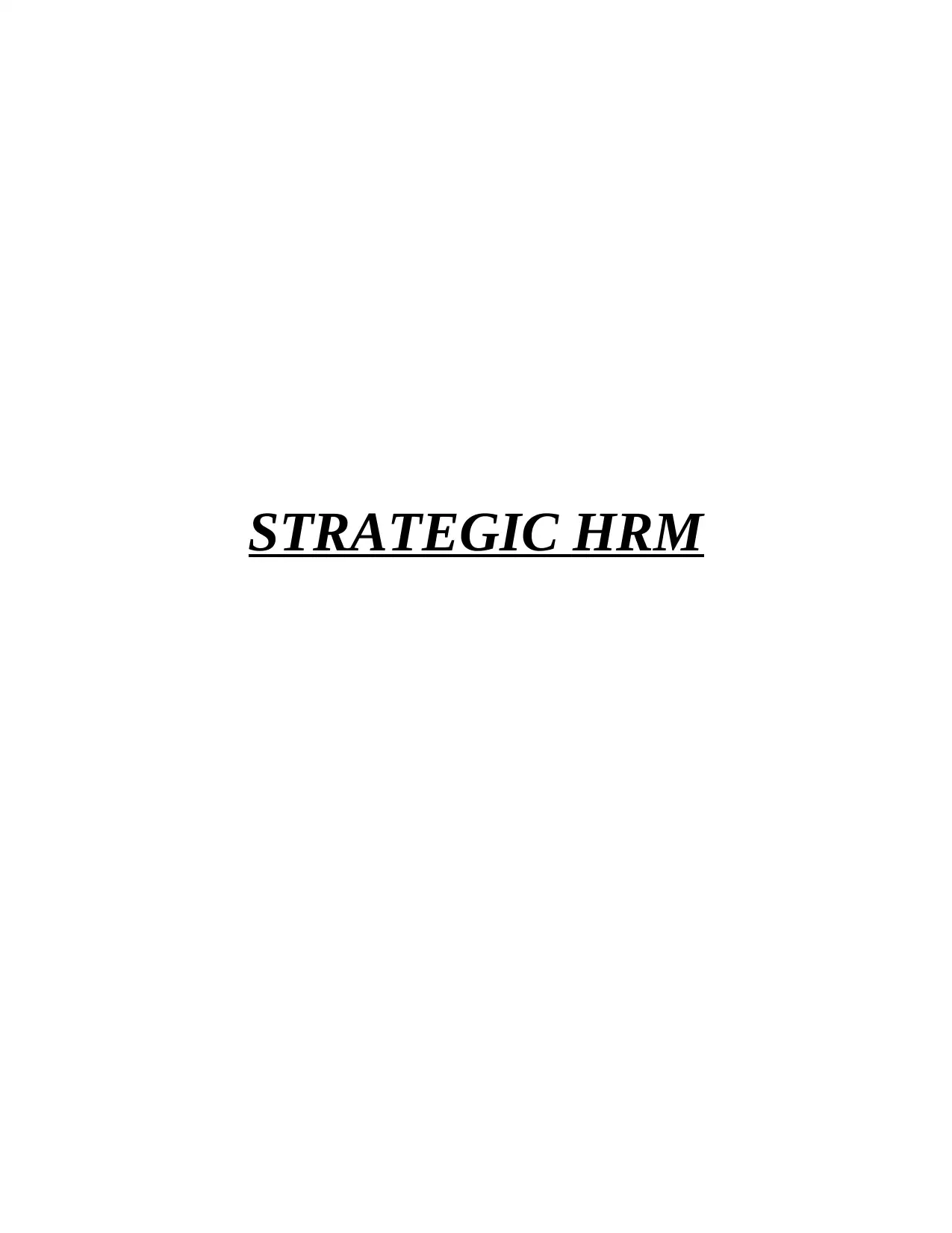
STRATEGIC HRM
Paraphrase This Document
Need a fresh take? Get an instant paraphrase of this document with our AI Paraphraser
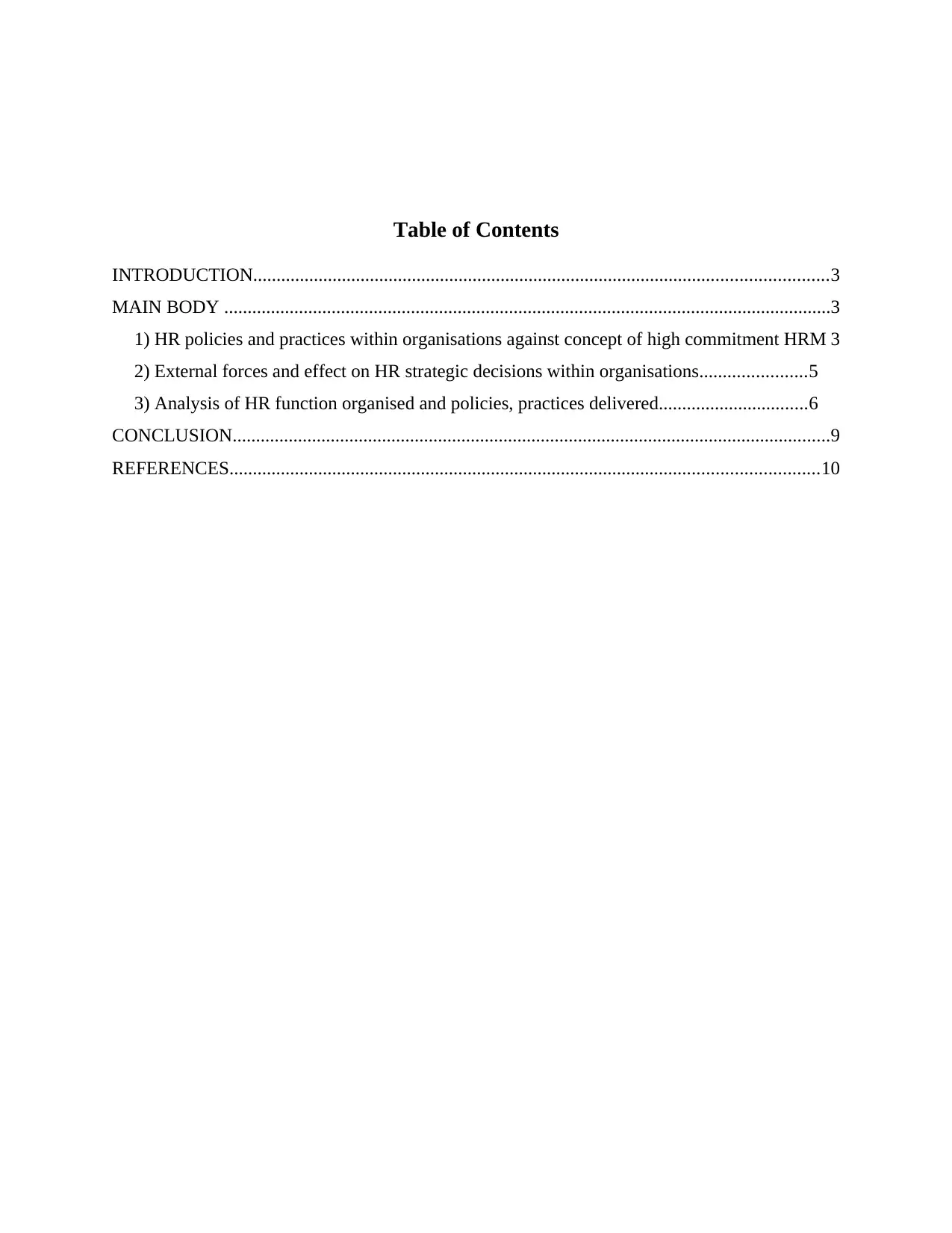
Table of Contents
INTRODUCTION...........................................................................................................................3
MAIN BODY ..................................................................................................................................3
1) HR policies and practices within organisations against concept of high commitment HRM 3
2) External forces and effect on HR strategic decisions within organisations.......................5
3) Analysis of HR function organised and policies, practices delivered................................6
CONCLUSION................................................................................................................................9
REFERENCES..............................................................................................................................10
INTRODUCTION...........................................................................................................................3
MAIN BODY ..................................................................................................................................3
1) HR policies and practices within organisations against concept of high commitment HRM 3
2) External forces and effect on HR strategic decisions within organisations.......................5
3) Analysis of HR function organised and policies, practices delivered................................6
CONCLUSION................................................................................................................................9
REFERENCES..............................................................................................................................10

⊘ This is a preview!⊘
Do you want full access?
Subscribe today to unlock all pages.

Trusted by 1+ million students worldwide
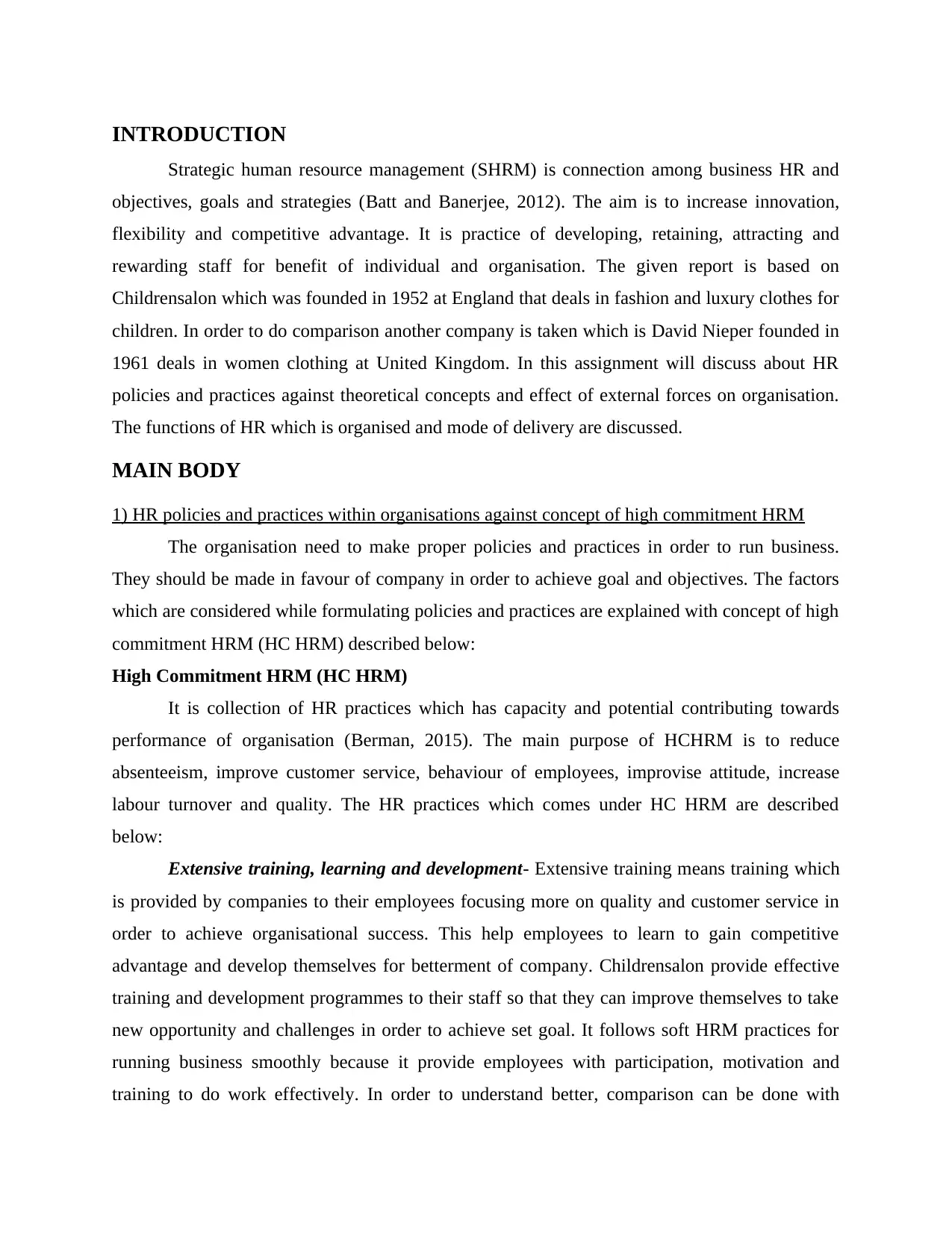
INTRODUCTION
Strategic human resource management (SHRM) is connection among business HR and
objectives, goals and strategies (Batt and Banerjee, 2012). The aim is to increase innovation,
flexibility and competitive advantage. It is practice of developing, retaining, attracting and
rewarding staff for benefit of individual and organisation. The given report is based on
Childrensalon which was founded in 1952 at England that deals in fashion and luxury clothes for
children. In order to do comparison another company is taken which is David Nieper founded in
1961 deals in women clothing at United Kingdom. In this assignment will discuss about HR
policies and practices against theoretical concepts and effect of external forces on organisation.
The functions of HR which is organised and mode of delivery are discussed.
MAIN BODY
1) HR policies and practices within organisations against concept of high commitment HRM
The organisation need to make proper policies and practices in order to run business.
They should be made in favour of company in order to achieve goal and objectives. The factors
which are considered while formulating policies and practices are explained with concept of high
commitment HRM (HC HRM) described below:
High Commitment HRM (HC HRM)
It is collection of HR practices which has capacity and potential contributing towards
performance of organisation (Berman, 2015). The main purpose of HCHRM is to reduce
absenteeism, improve customer service, behaviour of employees, improvise attitude, increase
labour turnover and quality. The HR practices which comes under HC HRM are described
below:
Extensive training, learning and development- Extensive training means training which
is provided by companies to their employees focusing more on quality and customer service in
order to achieve organisational success. This help employees to learn to gain competitive
advantage and develop themselves for betterment of company. Childrensalon provide effective
training and development programmes to their staff so that they can improve themselves to take
new opportunity and challenges in order to achieve set goal. It follows soft HRM practices for
running business smoothly because it provide employees with participation, motivation and
training to do work effectively. In order to understand better, comparison can be done with
Strategic human resource management (SHRM) is connection among business HR and
objectives, goals and strategies (Batt and Banerjee, 2012). The aim is to increase innovation,
flexibility and competitive advantage. It is practice of developing, retaining, attracting and
rewarding staff for benefit of individual and organisation. The given report is based on
Childrensalon which was founded in 1952 at England that deals in fashion and luxury clothes for
children. In order to do comparison another company is taken which is David Nieper founded in
1961 deals in women clothing at United Kingdom. In this assignment will discuss about HR
policies and practices against theoretical concepts and effect of external forces on organisation.
The functions of HR which is organised and mode of delivery are discussed.
MAIN BODY
1) HR policies and practices within organisations against concept of high commitment HRM
The organisation need to make proper policies and practices in order to run business.
They should be made in favour of company in order to achieve goal and objectives. The factors
which are considered while formulating policies and practices are explained with concept of high
commitment HRM (HC HRM) described below:
High Commitment HRM (HC HRM)
It is collection of HR practices which has capacity and potential contributing towards
performance of organisation (Berman, 2015). The main purpose of HCHRM is to reduce
absenteeism, improve customer service, behaviour of employees, improvise attitude, increase
labour turnover and quality. The HR practices which comes under HC HRM are described
below:
Extensive training, learning and development- Extensive training means training which
is provided by companies to their employees focusing more on quality and customer service in
order to achieve organisational success. This help employees to learn to gain competitive
advantage and develop themselves for betterment of company. Childrensalon provide effective
training and development programmes to their staff so that they can improve themselves to take
new opportunity and challenges in order to achieve set goal. It follows soft HRM practices for
running business smoothly because it provide employees with participation, motivation and
training to do work effectively. In order to understand better, comparison can be done with
Paraphrase This Document
Need a fresh take? Get an instant paraphrase of this document with our AI Paraphraser
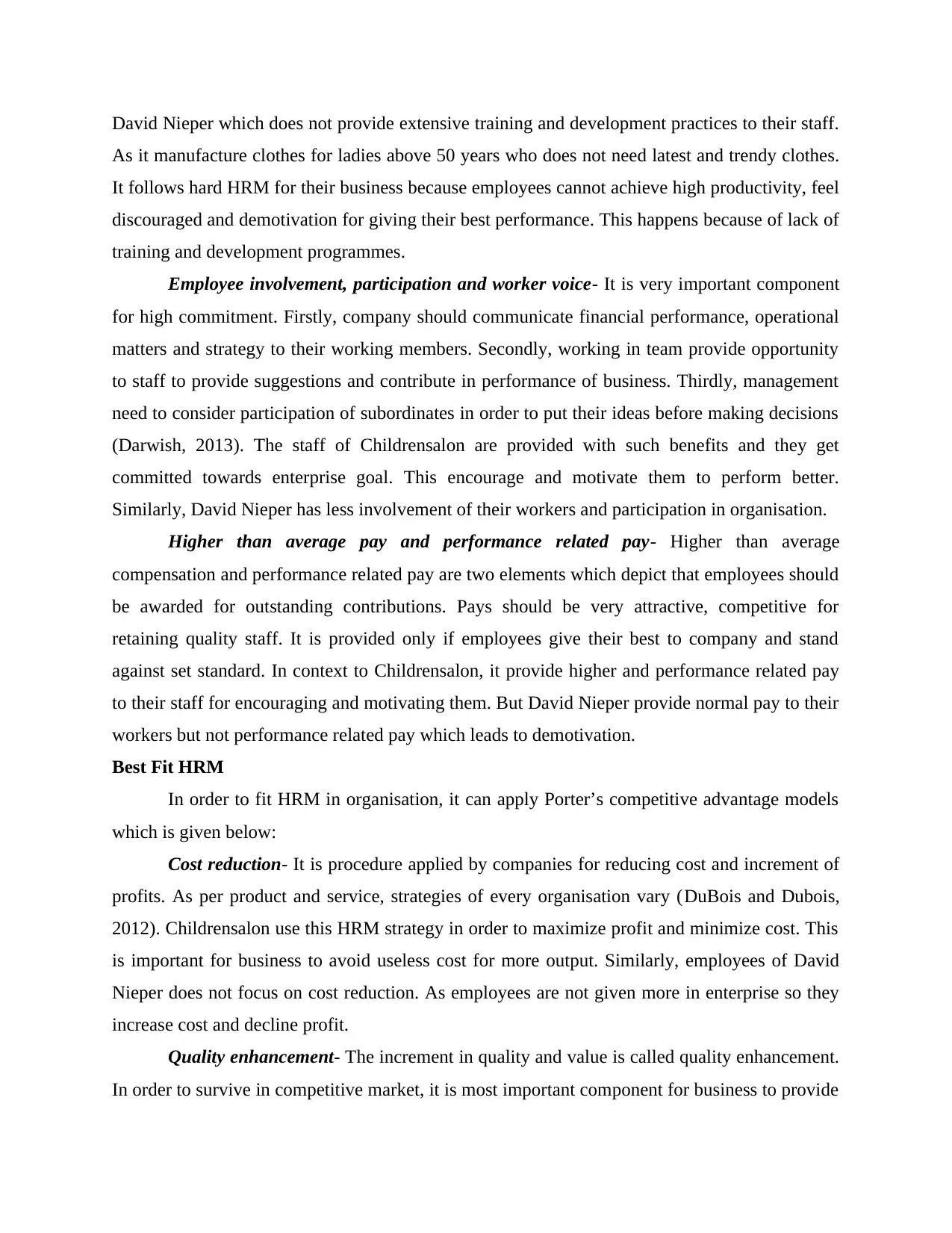
David Nieper which does not provide extensive training and development practices to their staff.
As it manufacture clothes for ladies above 50 years who does not need latest and trendy clothes.
It follows hard HRM for their business because employees cannot achieve high productivity, feel
discouraged and demotivation for giving their best performance. This happens because of lack of
training and development programmes.
Employee involvement, participation and worker voice- It is very important component
for high commitment. Firstly, company should communicate financial performance, operational
matters and strategy to their working members. Secondly, working in team provide opportunity
to staff to provide suggestions and contribute in performance of business. Thirdly, management
need to consider participation of subordinates in order to put their ideas before making decisions
(Darwish, 2013). The staff of Childrensalon are provided with such benefits and they get
committed towards enterprise goal. This encourage and motivate them to perform better.
Similarly, David Nieper has less involvement of their workers and participation in organisation.
Higher than average pay and performance related pay- Higher than average
compensation and performance related pay are two elements which depict that employees should
be awarded for outstanding contributions. Pays should be very attractive, competitive for
retaining quality staff. It is provided only if employees give their best to company and stand
against set standard. In context to Childrensalon, it provide higher and performance related pay
to their staff for encouraging and motivating them. But David Nieper provide normal pay to their
workers but not performance related pay which leads to demotivation.
Best Fit HRM
In order to fit HRM in organisation, it can apply Porter’s competitive advantage models
which is given below:
Cost reduction- It is procedure applied by companies for reducing cost and increment of
profits. As per product and service, strategies of every organisation vary (DuBois and Dubois,
2012). Childrensalon use this HRM strategy in order to maximize profit and minimize cost. This
is important for business to avoid useless cost for more output. Similarly, employees of David
Nieper does not focus on cost reduction. As employees are not given more in enterprise so they
increase cost and decline profit.
Quality enhancement- The increment in quality and value is called quality enhancement.
In order to survive in competitive market, it is most important component for business to provide
As it manufacture clothes for ladies above 50 years who does not need latest and trendy clothes.
It follows hard HRM for their business because employees cannot achieve high productivity, feel
discouraged and demotivation for giving their best performance. This happens because of lack of
training and development programmes.
Employee involvement, participation and worker voice- It is very important component
for high commitment. Firstly, company should communicate financial performance, operational
matters and strategy to their working members. Secondly, working in team provide opportunity
to staff to provide suggestions and contribute in performance of business. Thirdly, management
need to consider participation of subordinates in order to put their ideas before making decisions
(Darwish, 2013). The staff of Childrensalon are provided with such benefits and they get
committed towards enterprise goal. This encourage and motivate them to perform better.
Similarly, David Nieper has less involvement of their workers and participation in organisation.
Higher than average pay and performance related pay- Higher than average
compensation and performance related pay are two elements which depict that employees should
be awarded for outstanding contributions. Pays should be very attractive, competitive for
retaining quality staff. It is provided only if employees give their best to company and stand
against set standard. In context to Childrensalon, it provide higher and performance related pay
to their staff for encouraging and motivating them. But David Nieper provide normal pay to their
workers but not performance related pay which leads to demotivation.
Best Fit HRM
In order to fit HRM in organisation, it can apply Porter’s competitive advantage models
which is given below:
Cost reduction- It is procedure applied by companies for reducing cost and increment of
profits. As per product and service, strategies of every organisation vary (DuBois and Dubois,
2012). Childrensalon use this HRM strategy in order to maximize profit and minimize cost. This
is important for business to avoid useless cost for more output. Similarly, employees of David
Nieper does not focus on cost reduction. As employees are not given more in enterprise so they
increase cost and decline profit.
Quality enhancement- The increment in quality and value is called quality enhancement.
In order to survive in competitive market, it is most important component for business to provide
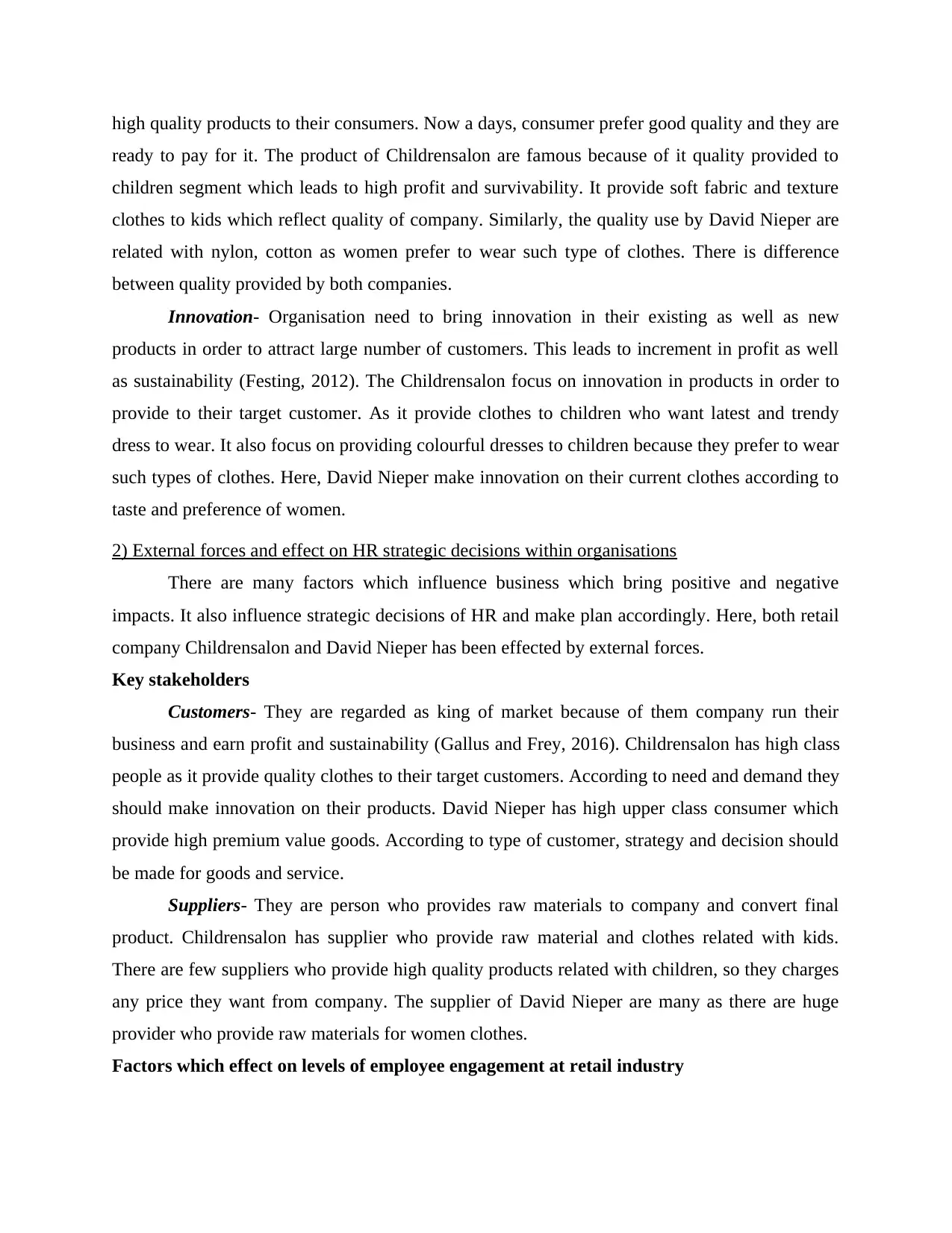
high quality products to their consumers. Now a days, consumer prefer good quality and they are
ready to pay for it. The product of Childrensalon are famous because of it quality provided to
children segment which leads to high profit and survivability. It provide soft fabric and texture
clothes to kids which reflect quality of company. Similarly, the quality use by David Nieper are
related with nylon, cotton as women prefer to wear such type of clothes. There is difference
between quality provided by both companies.
Innovation- Organisation need to bring innovation in their existing as well as new
products in order to attract large number of customers. This leads to increment in profit as well
as sustainability (Festing, 2012). The Childrensalon focus on innovation in products in order to
provide to their target customer. As it provide clothes to children who want latest and trendy
dress to wear. It also focus on providing colourful dresses to children because they prefer to wear
such types of clothes. Here, David Nieper make innovation on their current clothes according to
taste and preference of women.
2) External forces and effect on HR strategic decisions within organisations
There are many factors which influence business which bring positive and negative
impacts. It also influence strategic decisions of HR and make plan accordingly. Here, both retail
company Childrensalon and David Nieper has been effected by external forces.
Key stakeholders
Customers- They are regarded as king of market because of them company run their
business and earn profit and sustainability (Gallus and Frey, 2016). Childrensalon has high class
people as it provide quality clothes to their target customers. According to need and demand they
should make innovation on their products. David Nieper has high upper class consumer which
provide high premium value goods. According to type of customer, strategy and decision should
be made for goods and service.
Suppliers- They are person who provides raw materials to company and convert final
product. Childrensalon has supplier who provide raw material and clothes related with kids.
There are few suppliers who provide high quality products related with children, so they charges
any price they want from company. The supplier of David Nieper are many as there are huge
provider who provide raw materials for women clothes.
Factors which effect on levels of employee engagement at retail industry
ready to pay for it. The product of Childrensalon are famous because of it quality provided to
children segment which leads to high profit and survivability. It provide soft fabric and texture
clothes to kids which reflect quality of company. Similarly, the quality use by David Nieper are
related with nylon, cotton as women prefer to wear such type of clothes. There is difference
between quality provided by both companies.
Innovation- Organisation need to bring innovation in their existing as well as new
products in order to attract large number of customers. This leads to increment in profit as well
as sustainability (Festing, 2012). The Childrensalon focus on innovation in products in order to
provide to their target customer. As it provide clothes to children who want latest and trendy
dress to wear. It also focus on providing colourful dresses to children because they prefer to wear
such types of clothes. Here, David Nieper make innovation on their current clothes according to
taste and preference of women.
2) External forces and effect on HR strategic decisions within organisations
There are many factors which influence business which bring positive and negative
impacts. It also influence strategic decisions of HR and make plan accordingly. Here, both retail
company Childrensalon and David Nieper has been effected by external forces.
Key stakeholders
Customers- They are regarded as king of market because of them company run their
business and earn profit and sustainability (Gallus and Frey, 2016). Childrensalon has high class
people as it provide quality clothes to their target customers. According to need and demand they
should make innovation on their products. David Nieper has high upper class consumer which
provide high premium value goods. According to type of customer, strategy and decision should
be made for goods and service.
Suppliers- They are person who provides raw materials to company and convert final
product. Childrensalon has supplier who provide raw material and clothes related with kids.
There are few suppliers who provide high quality products related with children, so they charges
any price they want from company. The supplier of David Nieper are many as there are huge
provider who provide raw materials for women clothes.
Factors which effect on levels of employee engagement at retail industry
⊘ This is a preview!⊘
Do you want full access?
Subscribe today to unlock all pages.

Trusted by 1+ million students worldwide
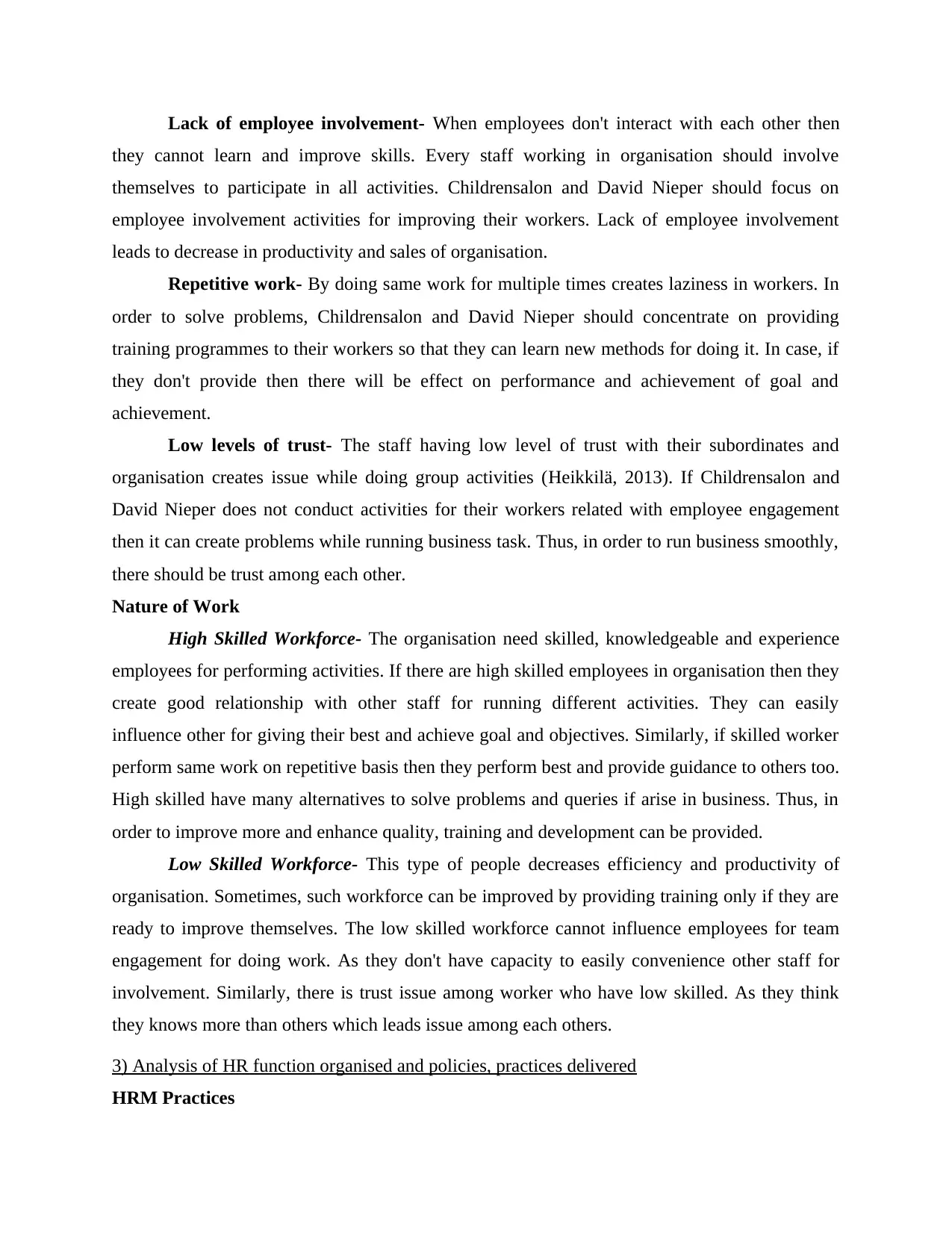
Lack of employee involvement- When employees don't interact with each other then
they cannot learn and improve skills. Every staff working in organisation should involve
themselves to participate in all activities. Childrensalon and David Nieper should focus on
employee involvement activities for improving their workers. Lack of employee involvement
leads to decrease in productivity and sales of organisation.
Repetitive work- By doing same work for multiple times creates laziness in workers. In
order to solve problems, Childrensalon and David Nieper should concentrate on providing
training programmes to their workers so that they can learn new methods for doing it. In case, if
they don't provide then there will be effect on performance and achievement of goal and
achievement.
Low levels of trust- The staff having low level of trust with their subordinates and
organisation creates issue while doing group activities (Heikkilä, 2013). If Childrensalon and
David Nieper does not conduct activities for their workers related with employee engagement
then it can create problems while running business task. Thus, in order to run business smoothly,
there should be trust among each other.
Nature of Work
High Skilled Workforce- The organisation need skilled, knowledgeable and experience
employees for performing activities. If there are high skilled employees in organisation then they
create good relationship with other staff for running different activities. They can easily
influence other for giving their best and achieve goal and objectives. Similarly, if skilled worker
perform same work on repetitive basis then they perform best and provide guidance to others too.
High skilled have many alternatives to solve problems and queries if arise in business. Thus, in
order to improve more and enhance quality, training and development can be provided.
Low Skilled Workforce- This type of people decreases efficiency and productivity of
organisation. Sometimes, such workforce can be improved by providing training only if they are
ready to improve themselves. The low skilled workforce cannot influence employees for team
engagement for doing work. As they don't have capacity to easily convenience other staff for
involvement. Similarly, there is trust issue among worker who have low skilled. As they think
they knows more than others which leads issue among each others.
3) Analysis of HR function organised and policies, practices delivered
HRM Practices
they cannot learn and improve skills. Every staff working in organisation should involve
themselves to participate in all activities. Childrensalon and David Nieper should focus on
employee involvement activities for improving their workers. Lack of employee involvement
leads to decrease in productivity and sales of organisation.
Repetitive work- By doing same work for multiple times creates laziness in workers. In
order to solve problems, Childrensalon and David Nieper should concentrate on providing
training programmes to their workers so that they can learn new methods for doing it. In case, if
they don't provide then there will be effect on performance and achievement of goal and
achievement.
Low levels of trust- The staff having low level of trust with their subordinates and
organisation creates issue while doing group activities (Heikkilä, 2013). If Childrensalon and
David Nieper does not conduct activities for their workers related with employee engagement
then it can create problems while running business task. Thus, in order to run business smoothly,
there should be trust among each other.
Nature of Work
High Skilled Workforce- The organisation need skilled, knowledgeable and experience
employees for performing activities. If there are high skilled employees in organisation then they
create good relationship with other staff for running different activities. They can easily
influence other for giving their best and achieve goal and objectives. Similarly, if skilled worker
perform same work on repetitive basis then they perform best and provide guidance to others too.
High skilled have many alternatives to solve problems and queries if arise in business. Thus, in
order to improve more and enhance quality, training and development can be provided.
Low Skilled Workforce- This type of people decreases efficiency and productivity of
organisation. Sometimes, such workforce can be improved by providing training only if they are
ready to improve themselves. The low skilled workforce cannot influence employees for team
engagement for doing work. As they don't have capacity to easily convenience other staff for
involvement. Similarly, there is trust issue among worker who have low skilled. As they think
they knows more than others which leads issue among each others.
3) Analysis of HR function organised and policies, practices delivered
HRM Practices
Paraphrase This Document
Need a fresh take? Get an instant paraphrase of this document with our AI Paraphraser
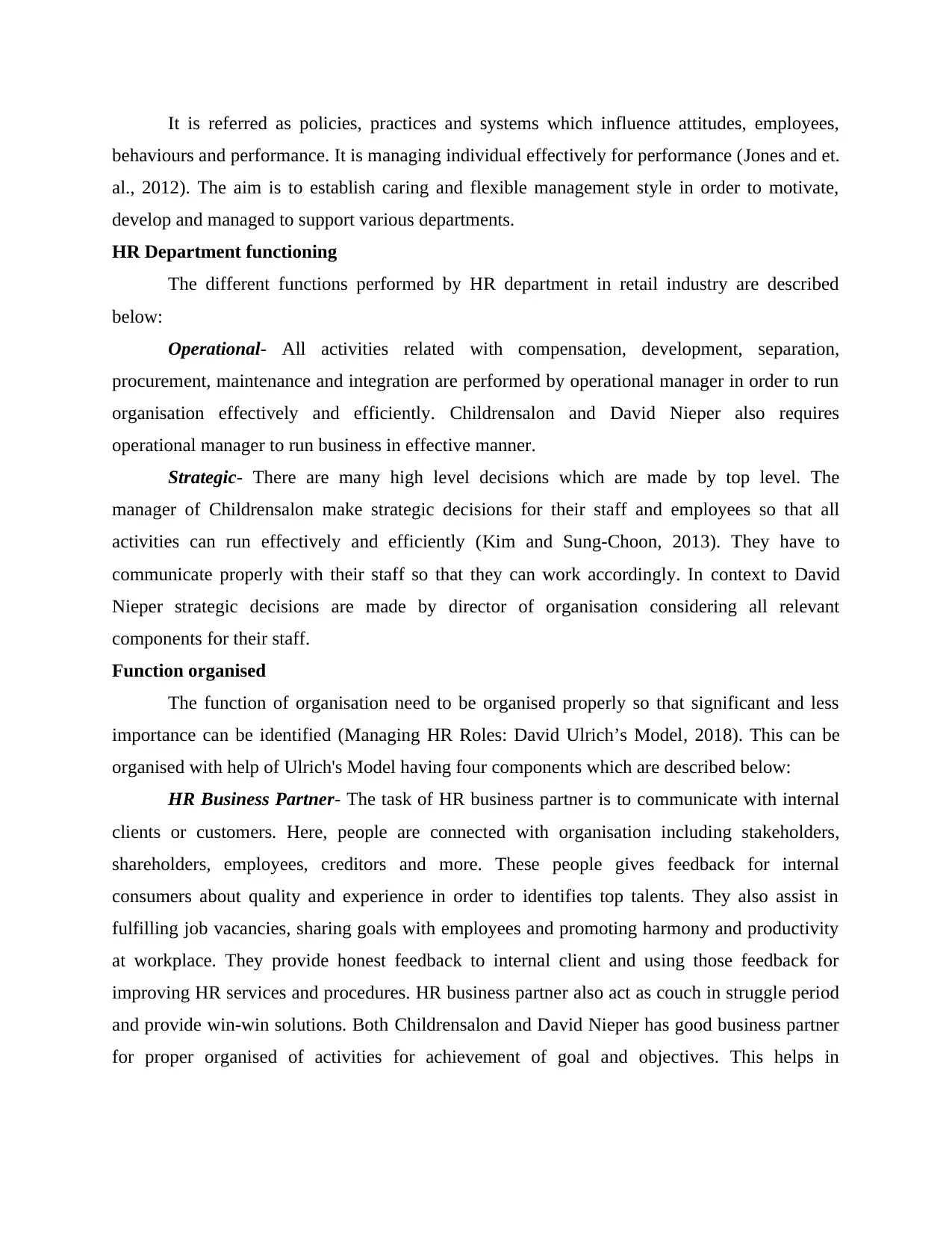
It is referred as policies, practices and systems which influence attitudes, employees,
behaviours and performance. It is managing individual effectively for performance (Jones and et.
al., 2012). The aim is to establish caring and flexible management style in order to motivate,
develop and managed to support various departments.
HR Department functioning
The different functions performed by HR department in retail industry are described
below:
Operational- All activities related with compensation, development, separation,
procurement, maintenance and integration are performed by operational manager in order to run
organisation effectively and efficiently. Childrensalon and David Nieper also requires
operational manager to run business in effective manner.
Strategic- There are many high level decisions which are made by top level. The
manager of Childrensalon make strategic decisions for their staff and employees so that all
activities can run effectively and efficiently (Kim and Sung-Choon, 2013). They have to
communicate properly with their staff so that they can work accordingly. In context to David
Nieper strategic decisions are made by director of organisation considering all relevant
components for their staff.
Function organised
The function of organisation need to be organised properly so that significant and less
importance can be identified (Managing HR Roles: David Ulrich’s Model, 2018). This can be
organised with help of Ulrich's Model having four components which are described below:
HR Business Partner- The task of HR business partner is to communicate with internal
clients or customers. Here, people are connected with organisation including stakeholders,
shareholders, employees, creditors and more. These people gives feedback for internal
consumers about quality and experience in order to identifies top talents. They also assist in
fulfilling job vacancies, sharing goals with employees and promoting harmony and productivity
at workplace. They provide honest feedback to internal client and using those feedback for
improving HR services and procedures. HR business partner also act as couch in struggle period
and provide win-win solutions. Both Childrensalon and David Nieper has good business partner
for proper organised of activities for achievement of goal and objectives. This helps in
behaviours and performance. It is managing individual effectively for performance (Jones and et.
al., 2012). The aim is to establish caring and flexible management style in order to motivate,
develop and managed to support various departments.
HR Department functioning
The different functions performed by HR department in retail industry are described
below:
Operational- All activities related with compensation, development, separation,
procurement, maintenance and integration are performed by operational manager in order to run
organisation effectively and efficiently. Childrensalon and David Nieper also requires
operational manager to run business in effective manner.
Strategic- There are many high level decisions which are made by top level. The
manager of Childrensalon make strategic decisions for their staff and employees so that all
activities can run effectively and efficiently (Kim and Sung-Choon, 2013). They have to
communicate properly with their staff so that they can work accordingly. In context to David
Nieper strategic decisions are made by director of organisation considering all relevant
components for their staff.
Function organised
The function of organisation need to be organised properly so that significant and less
importance can be identified (Managing HR Roles: David Ulrich’s Model, 2018). This can be
organised with help of Ulrich's Model having four components which are described below:
HR Business Partner- The task of HR business partner is to communicate with internal
clients or customers. Here, people are connected with organisation including stakeholders,
shareholders, employees, creditors and more. These people gives feedback for internal
consumers about quality and experience in order to identifies top talents. They also assist in
fulfilling job vacancies, sharing goals with employees and promoting harmony and productivity
at workplace. They provide honest feedback to internal client and using those feedback for
improving HR services and procedures. HR business partner also act as couch in struggle period
and provide win-win solutions. Both Childrensalon and David Nieper has good business partner
for proper organised of activities for achievement of goal and objectives. This helps in
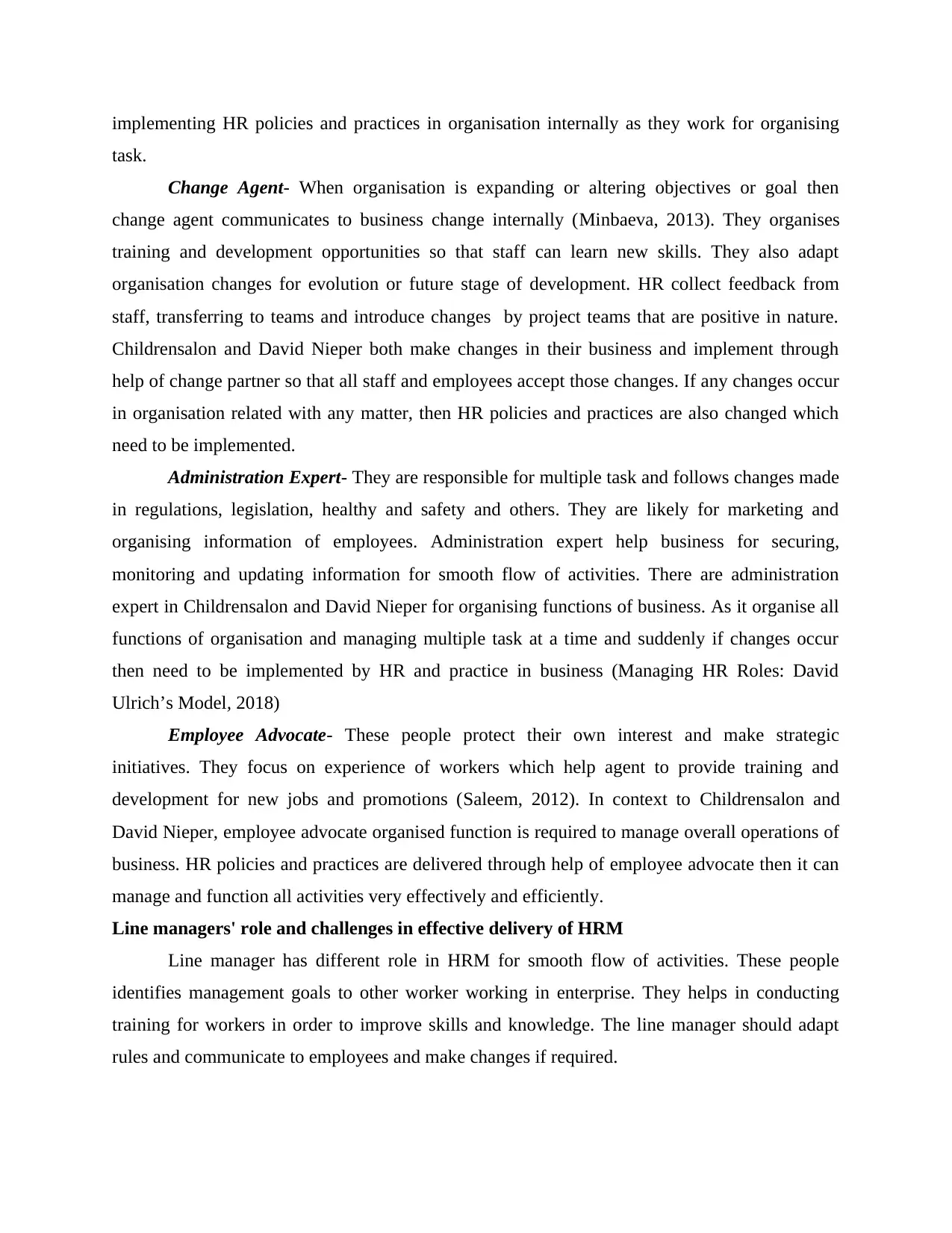
implementing HR policies and practices in organisation internally as they work for organising
task.
Change Agent- When organisation is expanding or altering objectives or goal then
change agent communicates to business change internally (Minbaeva, 2013). They organises
training and development opportunities so that staff can learn new skills. They also adapt
organisation changes for evolution or future stage of development. HR collect feedback from
staff, transferring to teams and introduce changes by project teams that are positive in nature.
Childrensalon and David Nieper both make changes in their business and implement through
help of change partner so that all staff and employees accept those changes. If any changes occur
in organisation related with any matter, then HR policies and practices are also changed which
need to be implemented.
Administration Expert- They are responsible for multiple task and follows changes made
in regulations, legislation, healthy and safety and others. They are likely for marketing and
organising information of employees. Administration expert help business for securing,
monitoring and updating information for smooth flow of activities. There are administration
expert in Childrensalon and David Nieper for organising functions of business. As it organise all
functions of organisation and managing multiple task at a time and suddenly if changes occur
then need to be implemented by HR and practice in business (Managing HR Roles: David
Ulrich’s Model, 2018)
Employee Advocate- These people protect their own interest and make strategic
initiatives. They focus on experience of workers which help agent to provide training and
development for new jobs and promotions (Saleem, 2012). In context to Childrensalon and
David Nieper, employee advocate organised function is required to manage overall operations of
business. HR policies and practices are delivered through help of employee advocate then it can
manage and function all activities very effectively and efficiently.
Line managers' role and challenges in effective delivery of HRM
Line manager has different role in HRM for smooth flow of activities. These people
identifies management goals to other worker working in enterprise. They helps in conducting
training for workers in order to improve skills and knowledge. The line manager should adapt
rules and communicate to employees and make changes if required.
task.
Change Agent- When organisation is expanding or altering objectives or goal then
change agent communicates to business change internally (Minbaeva, 2013). They organises
training and development opportunities so that staff can learn new skills. They also adapt
organisation changes for evolution or future stage of development. HR collect feedback from
staff, transferring to teams and introduce changes by project teams that are positive in nature.
Childrensalon and David Nieper both make changes in their business and implement through
help of change partner so that all staff and employees accept those changes. If any changes occur
in organisation related with any matter, then HR policies and practices are also changed which
need to be implemented.
Administration Expert- They are responsible for multiple task and follows changes made
in regulations, legislation, healthy and safety and others. They are likely for marketing and
organising information of employees. Administration expert help business for securing,
monitoring and updating information for smooth flow of activities. There are administration
expert in Childrensalon and David Nieper for organising functions of business. As it organise all
functions of organisation and managing multiple task at a time and suddenly if changes occur
then need to be implemented by HR and practice in business (Managing HR Roles: David
Ulrich’s Model, 2018)
Employee Advocate- These people protect their own interest and make strategic
initiatives. They focus on experience of workers which help agent to provide training and
development for new jobs and promotions (Saleem, 2012). In context to Childrensalon and
David Nieper, employee advocate organised function is required to manage overall operations of
business. HR policies and practices are delivered through help of employee advocate then it can
manage and function all activities very effectively and efficiently.
Line managers' role and challenges in effective delivery of HRM
Line manager has different role in HRM for smooth flow of activities. These people
identifies management goals to other worker working in enterprise. They helps in conducting
training for workers in order to improve skills and knowledge. The line manager should adapt
rules and communicate to employees and make changes if required.
⊘ This is a preview!⊘
Do you want full access?
Subscribe today to unlock all pages.

Trusted by 1+ million students worldwide
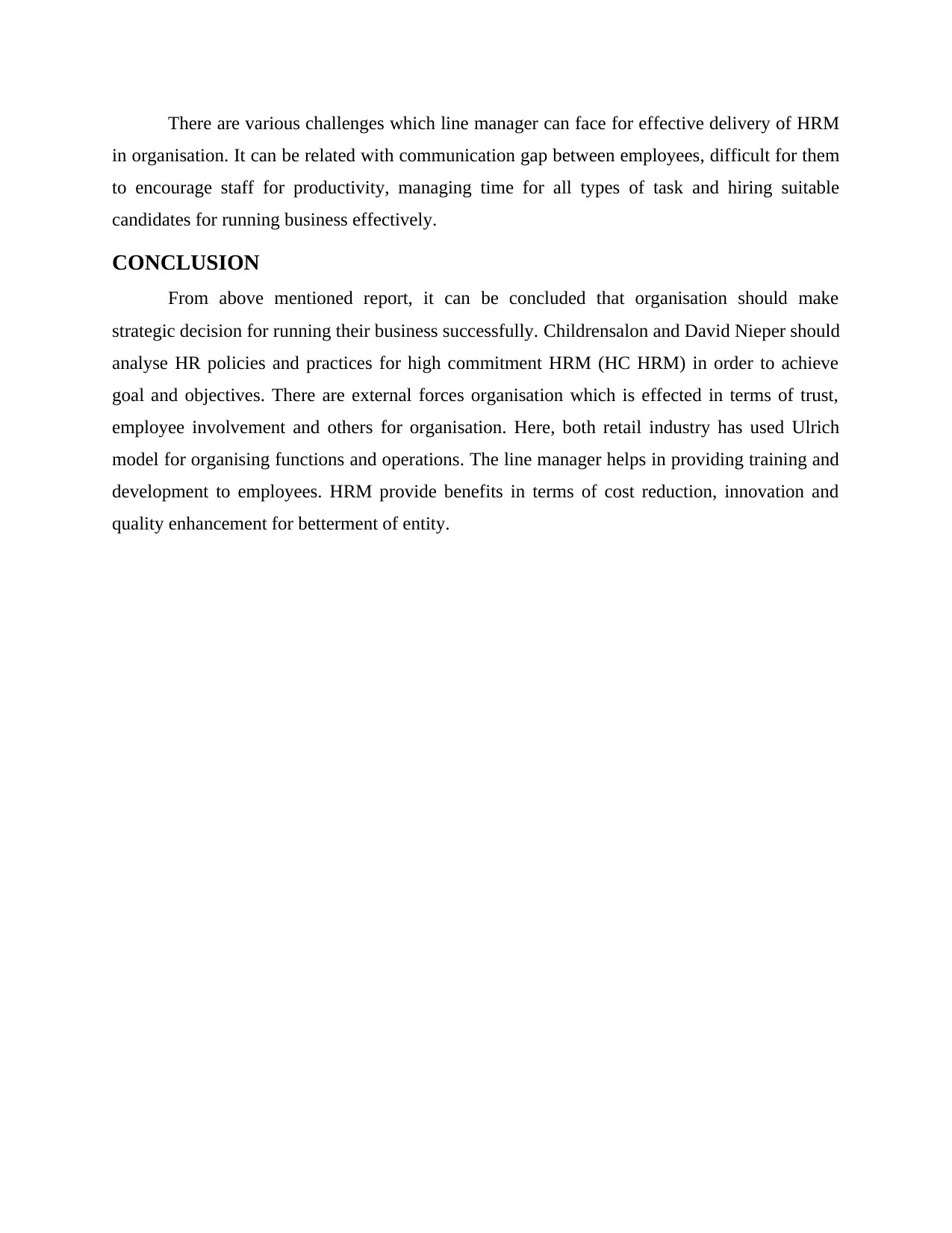
There are various challenges which line manager can face for effective delivery of HRM
in organisation. It can be related with communication gap between employees, difficult for them
to encourage staff for productivity, managing time for all types of task and hiring suitable
candidates for running business effectively.
CONCLUSION
From above mentioned report, it can be concluded that organisation should make
strategic decision for running their business successfully. Childrensalon and David Nieper should
analyse HR policies and practices for high commitment HRM (HC HRM) in order to achieve
goal and objectives. There are external forces organisation which is effected in terms of trust,
employee involvement and others for organisation. Here, both retail industry has used Ulrich
model for organising functions and operations. The line manager helps in providing training and
development to employees. HRM provide benefits in terms of cost reduction, innovation and
quality enhancement for betterment of entity.
in organisation. It can be related with communication gap between employees, difficult for them
to encourage staff for productivity, managing time for all types of task and hiring suitable
candidates for running business effectively.
CONCLUSION
From above mentioned report, it can be concluded that organisation should make
strategic decision for running their business successfully. Childrensalon and David Nieper should
analyse HR policies and practices for high commitment HRM (HC HRM) in order to achieve
goal and objectives. There are external forces organisation which is effected in terms of trust,
employee involvement and others for organisation. Here, both retail industry has used Ulrich
model for organising functions and operations. The line manager helps in providing training and
development to employees. HRM provide benefits in terms of cost reduction, innovation and
quality enhancement for betterment of entity.
Paraphrase This Document
Need a fresh take? Get an instant paraphrase of this document with our AI Paraphraser
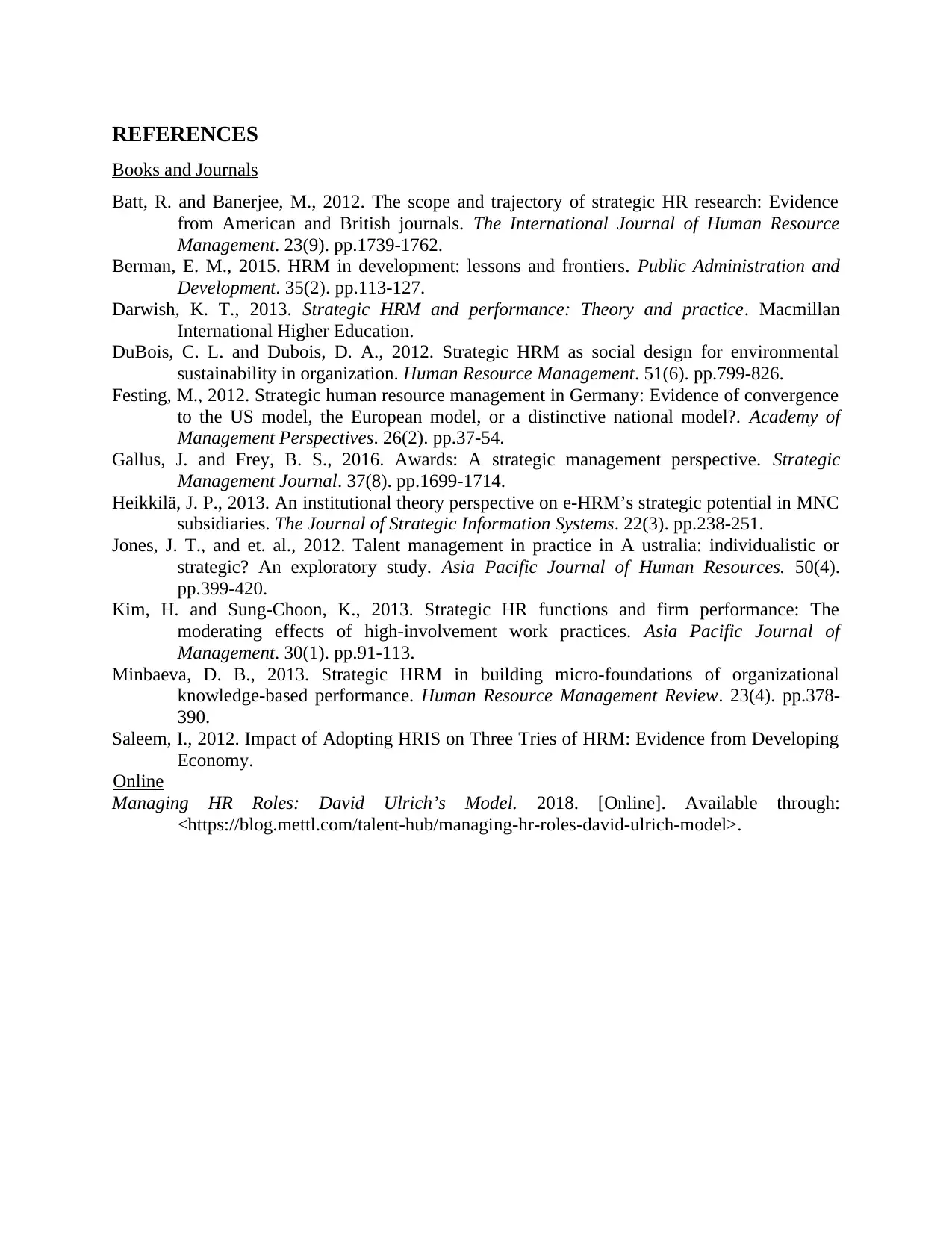
REFERENCES
Books and Journals
Batt, R. and Banerjee, M., 2012. The scope and trajectory of strategic HR research: Evidence
from American and British journals. The International Journal of Human Resource
Management. 23(9). pp.1739-1762.
Berman, E. M., 2015. HRM in development: lessons and frontiers. Public Administration and
Development. 35(2). pp.113-127.
Darwish, K. T., 2013. Strategic HRM and performance: Theory and practice. Macmillan
International Higher Education.
DuBois, C. L. and Dubois, D. A., 2012. Strategic HRM as social design for environmental
sustainability in organization. Human Resource Management. 51(6). pp.799-826.
Festing, M., 2012. Strategic human resource management in Germany: Evidence of convergence
to the US model, the European model, or a distinctive national model?. Academy of
Management Perspectives. 26(2). pp.37-54.
Gallus, J. and Frey, B. S., 2016. Awards: A strategic management perspective. Strategic
Management Journal. 37(8). pp.1699-1714.
Heikkilä, J. P., 2013. An institutional theory perspective on e-HRM’s strategic potential in MNC
subsidiaries. The Journal of Strategic Information Systems. 22(3). pp.238-251.
Jones, J. T., and et. al., 2012. Talent management in practice in A ustralia: individualistic or
strategic? An exploratory study. Asia Pacific Journal of Human Resources. 50(4).
pp.399-420.
Kim, H. and Sung-Choon, K., 2013. Strategic HR functions and firm performance: The
moderating effects of high-involvement work practices. Asia Pacific Journal of
Management. 30(1). pp.91-113.
Minbaeva, D. B., 2013. Strategic HRM in building micro-foundations of organizational
knowledge-based performance. Human Resource Management Review. 23(4). pp.378-
390.
Saleem, I., 2012. Impact of Adopting HRIS on Three Tries of HRM: Evidence from Developing
Economy.
Online
Managing HR Roles: David Ulrich’s Model. 2018. [Online]. Available through:
<https://blog.mettl.com/talent-hub/managing-hr-roles-david-ulrich-model>.
Books and Journals
Batt, R. and Banerjee, M., 2012. The scope and trajectory of strategic HR research: Evidence
from American and British journals. The International Journal of Human Resource
Management. 23(9). pp.1739-1762.
Berman, E. M., 2015. HRM in development: lessons and frontiers. Public Administration and
Development. 35(2). pp.113-127.
Darwish, K. T., 2013. Strategic HRM and performance: Theory and practice. Macmillan
International Higher Education.
DuBois, C. L. and Dubois, D. A., 2012. Strategic HRM as social design for environmental
sustainability in organization. Human Resource Management. 51(6). pp.799-826.
Festing, M., 2012. Strategic human resource management in Germany: Evidence of convergence
to the US model, the European model, or a distinctive national model?. Academy of
Management Perspectives. 26(2). pp.37-54.
Gallus, J. and Frey, B. S., 2016. Awards: A strategic management perspective. Strategic
Management Journal. 37(8). pp.1699-1714.
Heikkilä, J. P., 2013. An institutional theory perspective on e-HRM’s strategic potential in MNC
subsidiaries. The Journal of Strategic Information Systems. 22(3). pp.238-251.
Jones, J. T., and et. al., 2012. Talent management in practice in A ustralia: individualistic or
strategic? An exploratory study. Asia Pacific Journal of Human Resources. 50(4).
pp.399-420.
Kim, H. and Sung-Choon, K., 2013. Strategic HR functions and firm performance: The
moderating effects of high-involvement work practices. Asia Pacific Journal of
Management. 30(1). pp.91-113.
Minbaeva, D. B., 2013. Strategic HRM in building micro-foundations of organizational
knowledge-based performance. Human Resource Management Review. 23(4). pp.378-
390.
Saleem, I., 2012. Impact of Adopting HRIS on Three Tries of HRM: Evidence from Developing
Economy.
Online
Managing HR Roles: David Ulrich’s Model. 2018. [Online]. Available through:
<https://blog.mettl.com/talent-hub/managing-hr-roles-david-ulrich-model>.

⊘ This is a preview!⊘
Do you want full access?
Subscribe today to unlock all pages.

Trusted by 1+ million students worldwide
1 out of 12
Related Documents
Your All-in-One AI-Powered Toolkit for Academic Success.
+13062052269
info@desklib.com
Available 24*7 on WhatsApp / Email
![[object Object]](/_next/static/media/star-bottom.7253800d.svg)
Unlock your academic potential
Copyright © 2020–2025 A2Z Services. All Rights Reserved. Developed and managed by ZUCOL.





